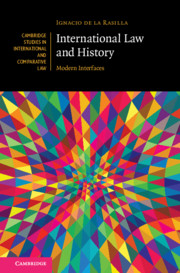Book contents
- International Law and History
- Cambridge Studies in International and Comparative Law: 152
- International Law and History
- Copyright page
- Dedication
- Epigraph
- Contents
- Acknowledgements
- Introduction
- 1 The Turn to the History of International Law
- 2 Contextual Approaches to the History of International Law
- 3 Critical/Postmodern Approaches to the History of International Law
- 4 TWAIL/Post-colonial Approaches to the History of International Law
- 5 Global Approaches to the History of International Law
- 6 Feminist Approaches to the History of International Law
- 7 Normative Approaches to the History of International Law
- 8 Sociological Approaches to the History of International Law
- 9 Institutional Approaches to the History of International Law
- 10 Biographical Approaches to the History of International Law
- 11 Multi-perspectivity and Periodization in the History of International Law
- Bibliography
- Index
- Cambridge Studies in International and Comparative Law
10 - Biographical Approaches to the History of International Law
Published online by Cambridge University Press: 07 January 2021
- International Law and History
- Cambridge Studies in International and Comparative Law: 152
- International Law and History
- Copyright page
- Dedication
- Epigraph
- Contents
- Acknowledgements
- Introduction
- 1 The Turn to the History of International Law
- 2 Contextual Approaches to the History of International Law
- 3 Critical/Postmodern Approaches to the History of International Law
- 4 TWAIL/Post-colonial Approaches to the History of International Law
- 5 Global Approaches to the History of International Law
- 6 Feminist Approaches to the History of International Law
- 7 Normative Approaches to the History of International Law
- 8 Sociological Approaches to the History of International Law
- 9 Institutional Approaches to the History of International Law
- 10 Biographical Approaches to the History of International Law
- 11 Multi-perspectivity and Periodization in the History of International Law
- Bibliography
- Index
- Cambridge Studies in International and Comparative Law
Summary
The lives, works, and times of international lawyers, thinkers, and scholars, who during their careers may often interchangeably play the roles of international judges, diplomats, or legal advisors to states, international institutions, transnational corporations, or non-governmental organizations, broadly constitute the scope of biographical approaches to the history of international law. A methodologically revamped turn to the cultivation of international ‘legal biography’ has been one of the characteristic features of the turn to the history of international law. Although reconstruction of the lives, works, and times of prominent international lawyers has long been a sub-genre in international legal scholarship, such lawyers and scholars have never been the object, apart from a very few limited exceptions, of professional historical biographical studies in the guise of those devoted to great statesmen or famous artists. The new wave of biographical approaches to the history of international law is thus characterized by a greater stress on the use of a ‘biographical tone’ and by more detailed attention to the political, intellectual, and professional contexts within which intellectually biographed international lawyers have contributed to the discipline over time. The turn to international legal biography has also encompassed a far greater coverage of the dramatis personae of the history of international law than was provided by earlier biographical accounts. The treatment they are currently receiving is, furthermore, more clearly influenced by the far larger diversity of animus historiandi underlying contemporary developments in historiography than hitherto in international legal history.
- Type
- Chapter
- Information
- International Law and HistoryModern Interfaces, pp. 308 - 338Publisher: Cambridge University PressPrint publication year: 2021



